Telangana TSBIE TS Inter 1st Year Botany Study Material 6th Lesson Modes of Reproduction Textbook Questions and Answers.
TS Inter 1st Year Botany Study Material 6th Lesson Modes of Reproduction
Very Short Answer Type Questions
Question 1.
What is the dominant phase in the life cycle of an angiosperm?
Answer:
- Multicellular diploid sporophytic stage is the dominant phase in the life cycle of an angiosperm.
- Sporophyte produces haploid spores via meiosis and a few called gametophytes.
Question 2.
What is meant by heterospory? Mention the two types of spores developed in an angiospermic plant?
Answer:
- Heterospory : A condition in which a plant produces two types of spores.
- They are microspores (Pollen grains) and megaspores (embryosac mother cells).
Question 3.
Mention the modes of reproductive in Algae and Fungi.
Answer:
- Algae (Chlamydomonas) reproduce asexually by motile zoospores, vegetatively by fragmentation and sexually by motile gametes.
- Fungi (Rhizopus) reproduce asexually by non-motile spores and conidia, vegetatively by fragmentation and sexually by gametes.
Question 4.
How do Liverworts reproduce vegetatively?
Answer:
- Liverworts reproduce vegetatively by specialised structure called gemmae.
- They also show vegetative reproduction via. fragmentation.
Question 5.
Mention any two characteristics of bacteria and yeast that enable them to reproduce asexually.
Answer:
- Both bacteria and yeast are single celled organisms, in which cell division itself is asexual reproduction.
- Bacteria reproduce by binary fission, while yeast reproduce by budding.
![]()
Question 6.
Why do we refer to offspring formed by asexual method of reproduction as clones?
Answer:
- Offspring formed by asexual vegetative method and that do not involve two parents are called clones.
- Clones of a plant are morphologically and genetically identical.
Question 7.
Between an annual and a perennial plant, which one has a shorter juvenile phase ? Give one reason.
Answer:
- Annual plant has a shorter juvenile or vegetative phase.
- Annuals like maize, wheat and rice have vegetative phase less than a year and that ends after flowering.
Question 8.
Rearrange the following events of sexual reproduction in the sequence in which they occur in a flowering plant: embryogenesis, fertilisation, gametogenesis, pollination.
Answer:
Pollination Gametogenesis Fertilisation Embryogenesis.
Question 9.
Is there a relationship between the size of an organism and its life span?
Answer:
- There is no absolute relationship between life span and size of an organism.
- Osmunda (Royal fern), a herbaceous plant lives for 100 + years. In general, plants that complete the life cycle (Wolffia) in short time are smaller as compared to plants, with long life span.
Question 10.
Give reasons as to why cell division can or cannot be a type of reproduction in multicellular organisms.
Answer:
- In muiiicelluiar organisms, often cell division (mitosis) leads to growth .
- But cell division (meiosis) in sex organs is responsible for reproduction via gamete formation.
Question 11.
Which of the following are monoecious and dioecious organisms?
a) Date palm b) Coconut c) Chara d) Marchantia
Answer:
a) Date palm – Dioecious
b) Coconut – Monoecious
c) Chara – Monoecious
d) Marchantia – Dioecious
Question 12.
Match the following given in column A with the vegetative propagules given in column B.
| Column A | Column B |
| i) Bryophyllum | a) offset |
| ii) Agave | b) eyes |
| iii) Potato | c) leaf buds |
| iv) Water hyacinth | d) fragmentation |
| v) Chara | e) sucker |
| vi) Mentha | f) bulbils |
Answer:
i) c ii) f iii) b iv) a v) d vi) e
Question 13.
What do the following parts of a flower develop into after fertilisation?
a) Ovary b) Stamens c) Ovules d) Calyx
Answer:
a) Ovary – fruit
b) Stamens – drops away
c) Ovule – seed
d) Calyx – withers away or drops away
![]()
Question 14.
Define vivipary with an example.
Answer:
- Vivipary of germination of seeds inside the fruit while still attached to the parent plant.
- In mangrove plants like Rhizophore, it is a strategy to lower the environmental stess and ensuring successful establishment of plantlet.
Short Answer Type Questions
Question 1.
In haploid organisms that undergo sexual reproduction. Name the stage in the life cycle where meiosis occurs. Give reasons for your answer.
Answer:
- Heploid organisms like chlamydomonas, chara etc., produce gametes (naploid) by mitotic division that fuse to form diploid zygote.
- In any haploid organism meiosis occurs after fertilization, in diploid cell.
- Meiotic division is meant for conservation of specific chromosome number of each species.
- In Fungi, Algae and Bryophytes having haploid plant body and haplontic life cycle meiosis occurs in zygote to restore the haploid chromosome number and to continue the life cycle.
Question 2.
The number of taxa exhibiting asexual reproduction is drastically reduced in higher plants (angiosperms) when compared to the lower groups of plants. Analyse the possible reasons to this situation.
Answer:
- In multicellular or colonial forms of algae, moulds and mushrooms vegetative reproduction by fragmentation is prime method of reproduction,
- Few taxa of angiosperms produce negetative propagules like runness, stolons, suckers etc., and most of species shifted to sexual reproduction.
- Vegetative reproduction does not involve two parents, formation of gametes and fertilization.
- Even the algae and fungi shift to sexual method of reproduction just before the onset of adverse conditions. In general, zygote formed by sexual reproduction is thick walled, resistant to dessication and damage.
- Further sexual reproduction brings about genetic recombination and variation. So, angiospermings have sexual mode of reproduction predominantly.
Question 3.
Is it possible to consider vegetative propagation’observed in plants like Bryophyllum, water hyacinth and ginger as a type of asexual reproduction? Give two / three reasons.
Answer:
a) Yes, reproductive leaves in Bryophyllurrt, offsets in water hyacinth and rhizome in ginger are vegetative propagules.
In asexual reproduction, a single individual (parent) is capable of producing offspring. Hence, the offspring produced are identical to each other and are also exact copies (clones) of their parent.
b) In production of vegetative propagules, there is no involvement of two parents, formation of gamete and fertilization.
![]()
Question 4.
“Fertilisation is not an obligatory event for fruit production in certain plants.” Explain the statement.
Answer:
In some plants parthenocarpy is observed. Parthenocarpy means development of fruits without fertilisation. They are seedless. The development of an embryo from unfertilised egg cell is known as parthenogenesis. It is a form of asexual reproduction. Hence fertilisation is not an obligatory event for fruit production in certain plants. Eg : Guava, pineapple etc.
Question 5.
List the changes observed in angiosperm flower subsequent to pollination and fertilisation. [Mar. ’17 – A.P. : Mar. ’14, ’13]
Answer:
Changes taking place in the angiospermic flower after fertilization are called post-fertilization changes.
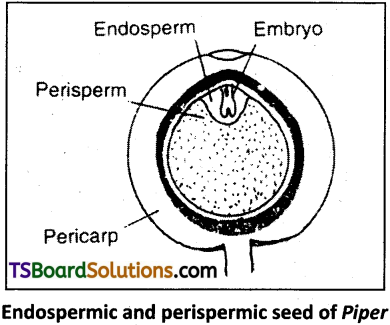
- Sepals, petals, stamens, styles and stigma fall off.
- After fertilization ovary develops into fruit. It stores food materials.
- Fertilized ovules develop into seeds.
- Zygote changes into – Embryo
- Synergids & Antipodals – Degenerate
- Primary endosperm nucleus forms – Endosperm
Question 6.
Suggest a possible explanation why the seeds in pea pod are arranged in a row, whereas those in tomato are scattered in the juicy pulp.
Answer:
- Seeds develop from ovules after post-fertilization changes, while dry transforms into fruit.
- In pea plant, there is marginal placentation. Ovules are borne on a ridge (placenta) along the yentral suture of the ovary. Hence, seeds are present in row in pea pod.
- In tomato, pariental placentation is present, the ovules develop on the inner wall of the ovary or on peripheral part. So seeds are scattered in juicy pulp formed from mesocarp and endocarp.
Question 7.
Justify the statement ‘Vegetative reproduction is also a type of asexual reproduction’. [May ’17]
Answer:
- Reproduction not involving the fusion of male and female gametes is called asexual reproduction.
- In Algae, moulds and mushrooms, the plant body break into smaller portions (fragmentation) and each fragment thing is formed and develops into a mature plant. Gemmae of liver worts are also vegetative reproductive structures.
- In flowering plants runner, stolon, sucker, offset rhizome, corm, tuber, bulb, bulbil, reproductive leaves are also vegetative propagules.
- In vegetative reproduction, there is no involvement of two parents, male and female gametes are not formed and are not fused. Offspring produced vegetatively by a plant are identical to one another and are exact copies (clones) of their parent.
- Hence, vegetative reproduction is also a type of asexual reproduction.
![]()
Question 8.
Define (a) Juvenile phase. (b) Reproductive phase. [Mar. – 2020]
Answer:
(a) Juvenile Phase :
All organisms have to reach a certain stage of growth and maturity in their life before they can reproduce sexually. This stage is known as Juvenile phase or Vegetative phase.
(b) Reproductive phase :
The end of juvenile phase is the beginning of reproductive phase. It can be seen easily in the higher plants when they come to flower.
Question 9.
Distinguish between asexual and sexual reproduction. Why is vegetative reproduction also considered as a type of asexual reproduction? [Mar. 15 – T.S.]
Answer:
- When an offspring is produced by a single parent with or without the involvement of gamete formation it is called asexual reproduction.
- Sexual reproduction involves the formation of the male and female gametes, either by the same individual or by different individuals of the opposite sex.
- Vegetative reproduction does not involve two parents, hence it is also considered as a type of asexual reproduction.
Question 10.
Identify each part in a flowering plant and write whether it is haploid (n) or diploid (2n). [Mar. – 2018]
(a) Ovary _____ (b) Anther _____ (c) Egg _____ (d) Pollen _____ (e) Male gamete _____ (f) Zygote _____
Answer:
a) Ovary – Diploid (2n)
b) Anther – Diploid (2n)
c) Egg – Haploid (n)
d) Pollen – Haploid (n)
e) Male gamete – Haploid (n)
f) Zygote – Diploid (2n)
Question 11.
Give a brief account on the phases of the life cycle of an angidsperm plant.
Answer:
- The life cycle of an angiospermic plant has two alternating phases namely the sporophytic and gametophytic phases.
- In angiosperms the plant body belongs to diploid (2n) sporophytic phase. This dominant phase of life cycle bears reproductive organs (flowers).
- The haploid (n) gametophytic phase of angiospermic plant is dervied from microspores (n) and megaspores (n).
- Microspores (pollen grains) are the meiotic products of microspore mother cells that develop in an anther.
- Megaspores are the meiotic products of megaspore mother cell that develop from the nucellus of the ovule.
- Micro and megaspores produce male and female gametophytes respectively.
- Male and female gametes formed respectively from male and female gametophytes are fused to form diploid (2n) zygote.
- Zygote after undergoing repeated mitotic divisions produce embryo in the seed.
- The embryo (2n) develops into a sporophytic plant during seed germination.
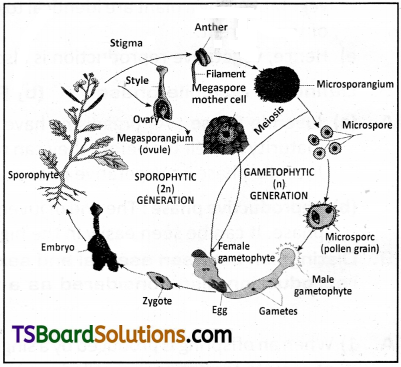
Long Answer Type Questions
Question 1.
Enumerate the differences between asexual and sexual reproduction. Describe the types of asexual reproduction exhibited by unicellular organisms.
Answer:
Differences between asexual and sexual reproduction :
| Asexual Reproduction | Sexual Reproduction |
| 1) Involves a single organism. | 1) Involves one or two organisms. |
| 2) No production of gametes. | 2) Male and female gametes are formed. |
| 3) No fusion of gametes. | 3) Involves fusion of male and female gametes. |
| 4) Requires only mitotic divisions. | 4) Required meiotic followed by mitotic divisions. |
| 5) Produces offspring that are identical to the parent. | 5) Offspring will have some characters from male parent and others from female parent. Some characters may not be present in either of the parents. |
| 6) Chance of genetic variation is only through random mutation. | 6) More chance for genetic variation. |
| 7) Not very useful for natural selection in evolution of species. | 7) Highly useful for natural selection in evolution of species. |
Asexual reproduction by unicellular organisms :
It is by binary fission, budding and spore formation.
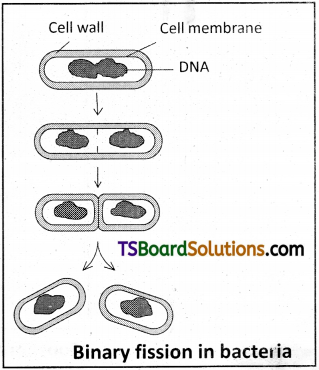
Binary fission :
Many unicellular organisms reproduce by binary fission. In this the parent cell divides into two equal halves and each one grows into new individuals. Eg : Euglena, bacteria etc. It is common in Protista and Monera.
Budding :
In yeast, asexual reproduction is done by budding. Small buds are produced that remain attached initially to the parent cell which eventually get separated and grows into new individual.
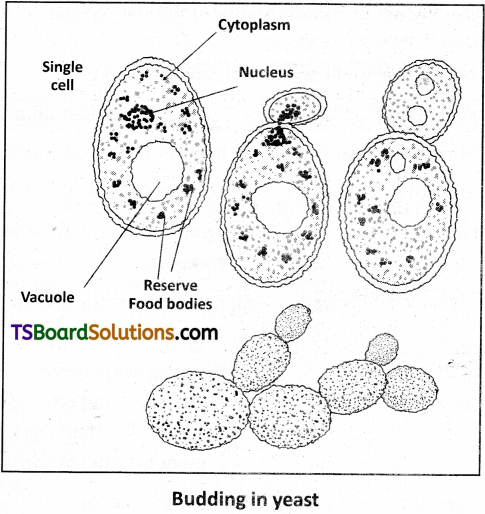
Spore :
In unicellular algae like Chlamydomonas asexual reproduction is done by spores. These spores are motile, hence called zoospores.
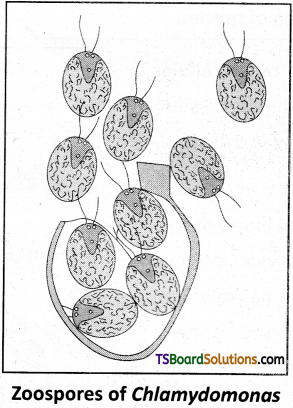
Question 2.
Although sexual reproduction is Song drawn, energy intensive complex forms of reproduction, many groups of organisms in kingdom plantae prefer this mode of reproduction. Give atleast three reasons for this.
Answer:
- Sexual reproduction involves formation of the male and female gametes, either by the same individual or by different individuals of the opposite sex. These gametes fuse to form the zygote which develops to forms the new organism.
- It is an elaborate, complex and slow process as compared to asexual reproduction.
- Sexual reproduction results in offspring that are not identical to the parents or amongst themselves due to fusion of male and female gametes.
- Sexual reproduction follow a regular sequence, and is characterized by the fusion (or fertilization) of the male and female gametes, the formation of zygote and embryogenesis. These sequential events may be grouped into 3 distinct stages namely, the pre-fertilization, fertilization and post-fertilization events.
A) Pre-fertilization events:
These include two events namely gametogenesis and gamete transfer that occur prior to the fusion of gametes. Gametogenesis refers to formation of two types (male and female) of gametes (haploid cells).
i) In some algae (eg. Cladophore) the two types of gametes may be so similar in appearance (isogametes) or may be two morphologidly distinct types (heterogametes) as in majority of sexually reproducing organisms. In plants that produce heterogametes (i.e., Runaria, Pteris and Cycas), the male gamete is called the antherozoid or sperm and the female gamete is called the egg.
ii) In some cases male and female gametes may be produced by same plant (bisexual), that has both male and female reproductive structures. In some other cases the male and female reproductive structures develop of two different plants of same species (unisexual). Bisexual condition can be denoted by terms such as homothallic (Fungi) and monoecious (plants). Similarly unisexual condition is described as heterothallic (Fungi) and dioecious (plants).
iii) In flowering plants, unisexual male flower being only stamen is called staminate and female flower bearing only pistils is called pistillate. In that case both male and female flowers may he present on same plant (monoecious cucurbits) or on two separate plants (dioecious – papaya and date palm).
iv) Organisms belonging to monera, fungi, algae and bryophytes have haploid plant body, they produce gametes by mitotic division. Whereas ptesido- phytes, gymnosperms and angiosperms having diploid plant body produce gametes through meiosis in meiocytes (gamete mother cells).
v) After the formation, male and female gametes must be physically brought together to facilitate fusion (fertilization). In majority of organisms (with exception of few fungi and algae), male gamete is motile and female gamete is stationary. In algae, bryophytes and pteridophytes water is the medium through which gamete transfer takes place.
vi) In seed plants pollen grains are the carriers of male gametes and ovule has the egg. in bisexual and self pollinating plants (Eg. Pea) pollen grains produced from anthers are transferred to stigma of same flower. But in cross pollinating plants (including dioecious) pollen from a flower reaches stigma of another flower).
vii) Pollen grains germinate on the stigma and pollen tubes carying the male gametes reach the ovule and discharge male gametes near the egg.
B) Fertilization :
It is the process of fusion of gametes and it is the most vital event of sexual reproduction. This process is also called as syngamy and result in the formation of a diploid zygote.
i) In majority of algae, syngamy occurs in the external medium (water) and is called external fertilization. But in many fungi and majority of plants (Bryophytes; Ptesidophytes, Gymnosperms and Angiosperms) syngamy (internal fertilization) occurs inside the body of the organism.
C) Post-fertilizaton events :
Events that occur after the formation of zygote are called as post-fertilization events. The diploid zygote is formed in all sexually reproducing organisms.
- In fungi and algae with haplontic life cycle zygote develops a thick wall that is resistant to desication and damage, undergoes a period of rest before germination. In those organisms zygote divides by meiosis immediately after keryogamy to form haploid spores that grow into haploid individuals.
- Zygote is the vital link that ensures continuity of species between organisms of one generation and the next.
- Every sexually reproducing organisms begins life as a single called zygote.
- Embryogenesis refers to the process of development of embryo from the zygote.
- During embryogenesis, zygote undergoes cell divisions (mitosis) and cell differention (formation of tissues and organs) to form an organism.
- In flowering plants, the zygote is formed inside the ovule, which transforms into seed. In angiosperms, seeds are present inside the fruit that formed from ovary.
Significance of sexual reproduction :
- Sexual reproduction enables the organisms to survive during unfavourable con¬ditions by producing resistant structures (thick walled zygote, seeds), So, even Algae and Fungi that have predominance of asexual/vegetative reproduction in life cycle shift to sexual process just before the onset of adverse conditions.
- Sexual reproduction involves fusion of gametes from two parents of opposite sex and hence responsible for genetic variation in offspring.
- Seeds are useful to surpass unfavourable conditions. In viviporous Mangroves seeds germinate on mother plant itself. This is a strategy to lower the environmental stress and ensuring successful establishment of plant let.
![]()
Question 3.
Describe the post-fertilisation changes in a flower. [Mar. ’17 – A.P]
Answer:
Changes taking place in the angiospermic flower after fertilization are called post-fertilization changes.
- Sepals, petals, stamens, styles and stigma fall off.
- In some members of Solanaceae, calyx remains persistent even after fertilisation and grows along with the fruit. In Asteraceae, persistent calyx, pappus helps in the fruits dispersal.
- After fertilization ovary develops into fruit. It stores food materials.
- Fertilized ovules develop into seeds.
- Part of ovule – Changes occurring after fertilization
Funiculus – Stalk of the seed
Outer integument – Testa (outer seed coat)
Inner integument – Tegmen (inner seed coat)
Micropyle – Seed pore
Zygote – Embryo
Synergids – Degenerate
Antipodals – Degenerate
Primary endosperm nucleus – Endosperm
Scar of the ovule – Hilum (scar of the seed)
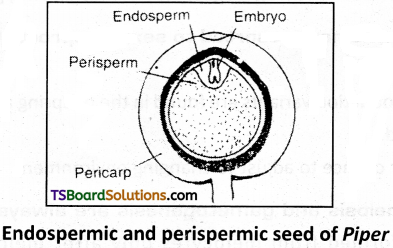
6) Endosperm is nutritive tissue useful for developing embryos. It is triploid in angiosperms and formed after fertilization.
Intext Question Answers
Question 1.
Why is reproduction essential for organisms?
Answer:
To ensure the continuity of species reproduction is essential. Reproduction will
- replace those species that die and
- allow an increase in total numbers of the species under suitable conditions.
Question 2.
Which is a better mode of reproduction sexual or asexual? Why?
Answer:
Sexual reproduction is the better mode of reproduction. It brings in diversity of characters in the new generation. It may give a better chance to adjust or adopt to changing environmental conditions, to tolerate diseases, to spread to new areas, to increase their population.
Question 3.
Why is the offspring formed by asexual reproduction referred to as clone?
Answer:
Offsprings formed by asexual method do not involve two parents. They are not only identical to one another but are also exact copies of their parent. Hence they are called clones.
![]()
Question 4.
How does the progeny formed from asexual reproduction differ from those formed by sexual reproduction?
Answer:
The progeny formed from asexual reproduction are genetically identical whereas those formed by sexual reproduction shows genetic variability.
Question 5.
What is vegetative propagation? Give two suitable examples.
Answer:
When the body breaks or gets separated into smaller portions, each fragment can develop into individual body. Eg: Algae, mould, mushrooms, ginger, turmeric, etc.
Question 6.
Higher organisms have resorted to sexual reproduction in spite of its complexity. Why?
Answer:
- In sexual reproduction variants are found in the offspring and their survival rate was enhanced.
- It gives better chance to adjust to changing environment.
Question 7.
Explain why meiosis and gametogenesis are always interlinked.
Answer:
Gametes are formed from meiocytes only after meiosis. This is called gametogenesis. Thus meiosis leads to the formation of gametes.
Question 8.
Define external fertilisation. Mention its disadvantages.
Answer:
In most aquatic organisms, such as algae, syngamy occurs in the external medium i. e., outside the body of the organism. This type of gametic fusion is called external fertilisation. Its disadvantage is they have to release a large number of gametes into the surrounding water in order to enhance the chances of syngamy.
Question 9.
Differentiate between a zoospore and a zygote.
Answer:
Zoospore is.a motile asexual spore that uses a flagellum for locomotion, also called a swarmspore, these spores are created by some algae, bacteria and fungi to propagate themselves.
Zygote is diploid, formed during sexual reproduction, by the fusion of male and female gametes.
Activity
Question 10.
Examine a few flowers of any cucurbit plant and try to identify the staminate and pistillate flowers. Do you know any other plant that ears unisexual flowers?
Answer:
Cucurbit plant show unisexual flowers. It bears only stamens in male flowers and only carpels in female flowers.
In coconut, male and female flowers are present on the same plant.
In Borasus, male flowers are present in male plant and female flowers are present in female plant.
![]()
Question 11.
What is a bisexual flower? Collect five bisexual flowers from your neighboured and with the help of your teacher find out their common and scientific names.
Answer:
The flower which has both androecium and gynoecium is called a bisexual flower. Collect different flowers as you collect for the herbarium.